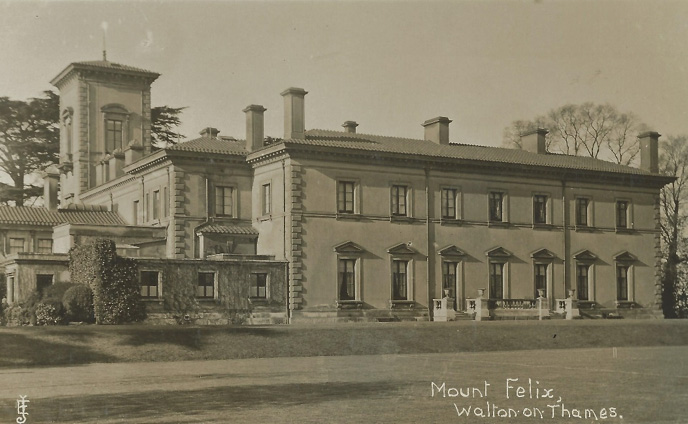This grand Italianate mansion once stood overlooking the Thames by Walton Bridge, with its grounds running alongside the river from the bridge to the Swan Hotel bordered to the south by Manor Road and Bridge Street.
A house existed there in the mid-17th century but in 1713 the land was acquired by Captain Harry Rodney, father of the future Admiral Lord Rodney, and a new house built. Other owners in the 18th century included Samuel Dicker a wealthy merchant and Member of Parliament who had the first Walton Bridge constructed in 1750.
In 1772 Charles Bennet, 4th Earl of Tankerville, acquired the estate and later built a new house called Felix Mount. The Earl’s Head Gardener, Edward ‘Lumpy’ Stevens, was also a leading Surrey cricketer, whose bowling was so accurate that in one match in 1775, he three times bowled the ball clean between the two-stump wicket without dislodging the bail.
This feat lead to the decision to introduce a third stump to the game of cricket. Edward Stevens’ tombstone still stands in Walton churchyard. The Earl inhabited the house until his death in 1822 and his wife remained there for another 14 years.
Between 1837 and 1840, Bennet’s son, the 5th Earl of Tankerville, had a new house designed by Charles Barry, later responsible for the present Houses of Parliament. Barry designed a mansion in the Italian style, incorporating a 70 foot (21.3 metre) tower, and the building was renamed Mount Felix.
In 1856 the 5th Earl sold it to Herbert Ingram, founder of The Illustrated London News and a Member of Parliament. His widow died there 40 years later and the property was acquired by John Cook, son of Thomas Cook, founder of the travel agency. He had Walton’s first telephone installed and provided a field for the use of Walton’s first football club.
John Cook sadly died in 1899 after a visit to Jerusalem and the house stood empty for several years. The grounds however were utilised by film pioneer Cecil Hepworth and in 1903 the outdoor scenes of the first ever film adaption of Lewis Carroll’s Alice in Wonderland were shot there.
Possibilities for its use as council offices, library and museum or country club fell through, but with the outbreak of World War One it was requisitioned for use as a military hospital particularly for New Zealand soldiers between 1915 and 1920. This period of its history has been described in more detail by Nick Pollard in Walton Matters Issue 3.
After the house was converted into flats and much of the land sold off, it came into the ownership of the Local Authority in 1965 after they refused an application for demolition. However, a disastrous fire the following year destroyed much of the building, resulting in the demolition of everything including the tower which, for a while, it was hoped would be saved.
Today the stable block and some nineteenth century out-buildings survive along with the entrance pillars opposite Oatlands Drive, which still bear the Ingram family arms. The site of the mansion is now built over but one of the Cedars which formerly flanked the tower still stands as a landmark and reminder of one of England’s lost historic houses.
References:- Mount Felix, John Stonebanks; Walton and Weybridge Local History Society, 1978. Walton Past, Bryan Ellis, Phillimore; 2002. Photo – Mount Felix , East View c.1910.(Private collection)

